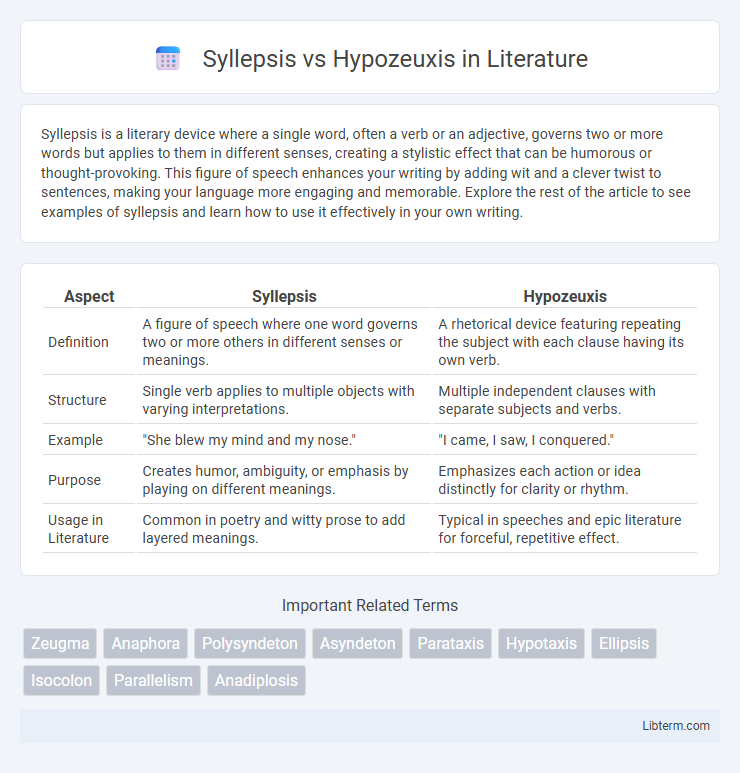Syllepsis is a literary device where a single word, often a verb or an adjective, governs two or more words but applies to them in different senses, creating a stylistic effect that can be humorous or thought-provoking. This figure of speech enhances your writing by adding wit and a clever twist to sentences, making your language more engaging and memorable. Explore the rest of the article to see examples of syllepsis and learn how to use it effectively in your own writing.
Table of Comparison
| Aspect | Syllepsis | Hypozeuxis |
|---|---|---|
| Definition | A figure of speech where one word governs two or more others in different senses or meanings. | A rhetorical device featuring repeating the subject with each clause having its own verb. |
| Structure | Single verb applies to multiple objects with varying interpretations. | Multiple independent clauses with separate subjects and verbs. |
| Example | "She blew my mind and my nose." | "I came, I saw, I conquered." |
| Purpose | Creates humor, ambiguity, or emphasis by playing on different meanings. | Emphasizes each action or idea distinctly for clarity or rhythm. |
| Usage in Literature | Common in poetry and witty prose to add layered meanings. | Typical in speeches and epic literature for forceful, repetitive effect. |
Introduction to Syllepsis and Hypozeuxis
Syllepsis is a rhetorical device where a single word governs multiple parts of a sentence, often combining different meanings, creating a stylistic or humorous effect. Hypozeuxis involves using separate clauses with their own subject and predicate, emphasizing clarity and impact in parallel structures. Understanding the distinction between syllepsis and hypozeuxis enhances mastery of syntactic and semantic nuances in language.
Defining Syllepsis
Syllepsis is a rhetorical device where a single word, often a verb or an adjective, governs or modifies two or more words in different senses, creating a unique play on meaning. Unlike hypozeuxis, where each clause or phrase has its own independent verb, syllepsis links multiple parts of a sentence through one shared word, enhancing stylistic effect and semantic richness. This contrast highlights syllepsis's role in combining disparate ideas under a unified linguistic structure for emphasis or humor.
Defining Hypozeuxis
Hypozeuxis is a rhetorical device where each clause has its own independent subject and verb, creating clear and structurally parallel statements. Unlike syllepsis, which shares a single word or phrase across different parts of a sentence with varying meanings or grammatical relations, hypozeugis emphasizes clarity and repetition of syntactic elements. This technique enhances the rhythm and force of expression by maintaining distinct and complete ideas within each clause.
Historical Origins and Usage
Syllepsis and hypozeuxis trace their historical origins to classical rhetoric, with syllepsis deriving from Greek roots meaning "to seize together," often used by ancient orators to create witty or ironic effects by applying one word to multiple others in different senses. Hypozeuxis, also from Greek meaning "under-binding," involves the repetition of the same subject-verb structure in successive clauses, emphasizing clarity and rhythm in speeches and literary works of antiquity. Both devices have been employed since ancient times to enhance persuasive communication, with syllepsis highlighting semantic ambiguity and hypozeuxis reinforcing logical structure.
Key Differences Between Syllepsis and Hypozeuxis
Syllepsis involves a single word that governs two or more words or phrases, often creating a play on meanings, while hypozeuxis features each clause having its own subject and predicate, emphasizing clear separation of ideas. Syllepsis merges syntax or semantics between elements, whereas hypozeuxis maintains parallelism with complete, independent clauses. The key difference lies in syllepsis's intentional ambiguity or dual meanings versus hypozeuxis's straightforward, repetitive structure.
Notable Examples in Literature
Syllepsis appears in literature such as Lewis Carroll's "Alice's Adventures in Wonderland," where a verb governs two objects differently, exemplifying linguistic playfulness. Hypozeuxis is evident in Shakespeare's works, with parallel clauses each having distinct subjects and verbs, like in "Julius Caesar," enhancing rhetorical emphasis. These figures of speech highlight complex syntactic structures used to create nuanced meaning and stylistic effects.
Functions and Effects in Rhetoric
Syllepsis and hypozeuxis serve distinct rhetorical functions by manipulating sentence structure to create emphasis and impact. Syllepsis combines a single word with two others in different senses, creating a witty or humorous effect that enhances memorability and engagement. Hypozeuxis features each clause with its own subject and verb, generating clarity and rhythmic intensity that underscores key arguments or emotions in discourse.
Common Mistakes and Misinterpretations
Syllepsis often leads to confusion when a single word governs two others in different senses, causing misinterpretations in meaning, such as "He caught the train and a cold," where "caught" applies differently. Hypozeuxis, featuring each clause with its own subject and verb, is frequently mistaken for simple parallelism but actually emphasizes distinct, parallel actions or ideas. Common errors include blending these devices or misidentifying syllepsis as a simple pun, which undermines the nuanced rhetorical effect each creates.
Practical Applications for Writers
Syllepsis enhances writing by creating concise, witty sentences that engage readers through clever wordplay and dual meanings, making it ideal for humor, advertising, and persuasive texts. Hypozeuxis improves clarity by assigning individual verbs to each clause, which benefits analytical writing, academic papers, and detailed narratives where precision is crucial. Writers can strategically use syllepsis to add stylistic flair and hypozeuxis to maintain clear, deliberate communication.
Conclusion: Choosing the Right Device
Choosing between syllepsis and hypozeuxis hinges on the desired rhetorical impact and clarity; syllepsis creates a witty, often ambiguous effect by linking a single word to multiple meanings, while hypozeuxis delivers straightforward, parallel structure for emphasis and clarity. Syllepsis suits creative and humorous contexts, enhancing engagement through linguistic playfulness. Hypozeuxis is preferable for formal or persuasive writing where precise, unambiguous communication is essential.
Syllepsis Infographic

 libterm.com
libterm.com